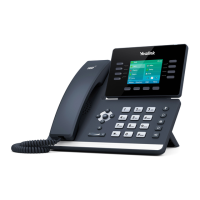Setting Up Your System
135
events), call log files and contact files to the provisioning server. You can configure a separate
directory for each of these files to help organize: a log file directory, a call log file directory and
a contact file directory. For more information, refer to Viewing Log Files on page 963, Backing
up the Call Log on page 343 and Backing up the Local Contacts on page 367.
Manual Provisioning
When you manually configure a phone via web user interface or phone user interface, the
changes associated with non-static settings you make will be stored in the MAC-local CFG file.
For more information on MAC-local CFG file, refer to MAC-local CFG File on page 139. This file
is stored on the phone, but a copy can be also uploaded to the provisioning server or a specific
URL (if configured).
There are two ways to manually provision IP phones:
Web User Interface
Phone User Interface
Web User Interface
You can configure IP phones via web user interface, a web-based interface that is especially
useful for remote configuration. Because features and configurations vary by phone model and
firmware version, options available on each page of the web user interface can vary.
An administrator or a user can configure IP phones via web user interface; but accessing the
web user interface requires password. The default user name and password for the
administrator are both “admin” (case-sensitive). The default user name and password for the
user are both “user” (case-sensitive). For more information on configuring passwords, refer to
User and Administrator Passwords on page 923.
This method enables you to perform configuration changes on a per-phone basis. Note that
the features can be configured via web user interface are limited. So, you can use the web user
interface method as the sole configuration method or in conjunction with central provisioning
method and phone user interface method.
IP phones support both HTTP and HTTPS protocols for accessing the web user interface. For
more information, refer to Web Server Type on page 66.
Phone User Interface
You can configure IP phones via phone user interface on a per-phone basis. As with the web
user interface, phone user interface makes configurations available to users and administrators;
but the Advanced/Advanced Settings option is only available to administrators and requires
an administrator password (default: admin). For more information on configuring password,
refer to User and Administrator Passwords on page 923.
If you want to reset all settings made from the phone user interface to default, refer to
Yealink
phone-specific user guide
.

